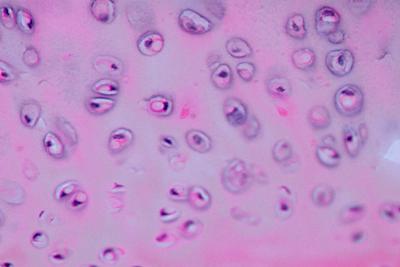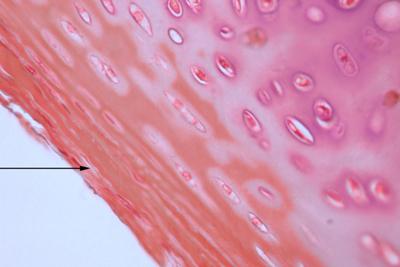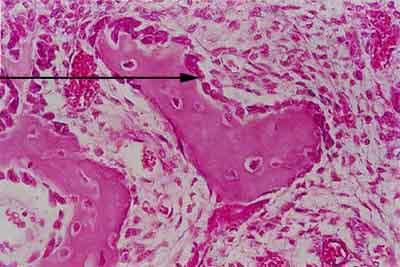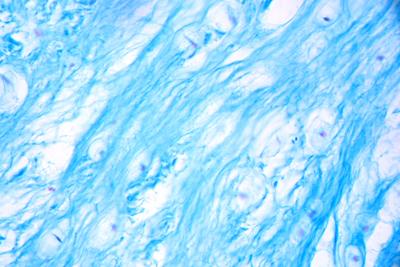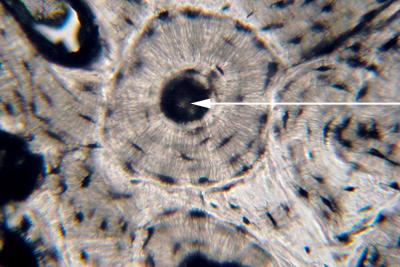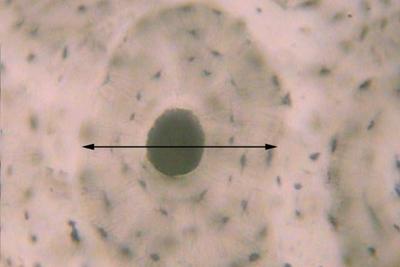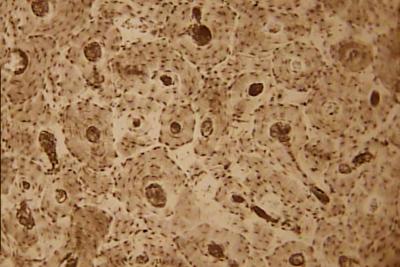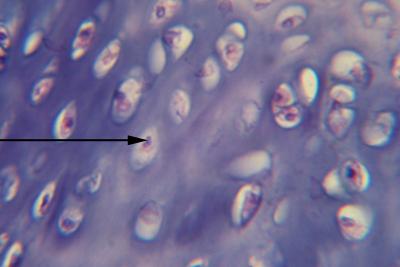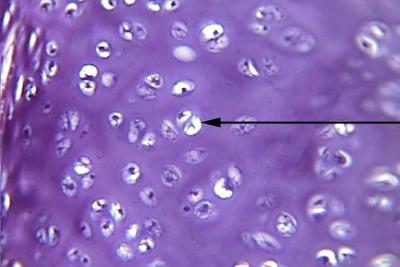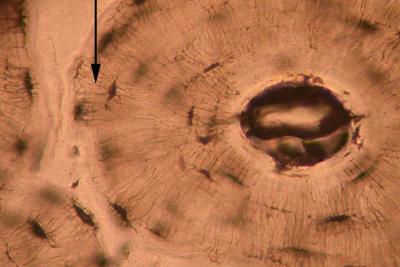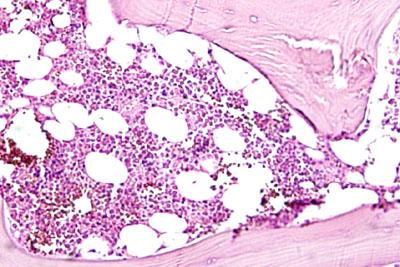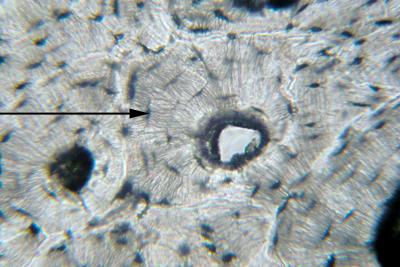Cartilage And Bone Quiz! Trivia
(184).jpg)
.
- 1.
Identify this tissue:
- A.
Elastic cartilage
- B.
Compact bone
- C.
Hyaline cartilage
- D.
Fibrocartilage
Correct Answer
C. Hyaline cartilageExplanation
Hyaline cartilage is a type of connective tissue characterized by its clear, glassy appearance under a microscope. It is found in various parts of the body such as the nose, trachea, and ends of long bones. Hyaline cartilage provides support and flexibility to these structures. It is composed of collagen fibers embedded in a gel-like matrix, giving it a smooth and shiny surface. This tissue helps to reduce friction between bones and absorb shock, making it an essential component of joints.Rate this question:
-
- 2.
What is the pointer on?
- A.
Perichondrium
- B.
Periosteum
- C.
Stratified squamous epithelium
- D.
Dense regular connective tissue
Correct Answer
A. PerichondriumExplanation
Reference: This is a slide of hyaline cartilageRate this question:
-
- 3.
Which tissue makes up the fetal skeleton?
- A.
A
- B.
B
- C.
C
- D.
D
Correct Answer
C. CExplanation
Reference: A is elastic cartilage; B is fibrocartilage; C is hyaline cartilage; D is bone.Rate this question:
-
- 4.
Identify the structure at the pointer.
- A.
Osteoblast
- B.
Osteocyte
- C.
Chondrocyte
- D.
Chondroblast
Correct Answer
A. OsteoblastExplanation
The correct answer is Osteoblast. Osteoblasts are bone-forming cells that are responsible for the production and secretion of the extracellular matrix of bone tissue. They play a crucial role in bone development and remodeling. Osteoblasts are typically found on the surface of bone and are involved in the mineralization of the bone matrix.Rate this question:
-
- 5.
What tissue type are the hammer, anvil, and stirrup?
- A.
A
- B.
B
- C.
C
- D.
D
Correct Answer
A. AExplanation
Reference: A is elastic cartilage; B is fibrocartilage; C is hyaline cartilage; D is bone.Rate this question:
-
- 6.
Which tissue makes up the intervertebral disc?
- A.
A
- B.
B
- C.
C
- D.
D
Correct Answer
B. BExplanation
Reference: A is elastic cartilage; B is fibrocartilage; C is hyaline cartilage; D is bone.Rate this question:
-
- 7.
Identify this tissue:
- A.
Spongy bone
- B.
Hyaline cartilage
- C.
Fibrocartilage
- D.
Elastic cartilage
Correct Answer
C. FibrocartilageExplanation
Fibrocartilage is a type of connective tissue that is found in areas that require both support and flexibility, such as the intervertebral discs, pubic symphysis, and menisci of the knee. It is composed of dense collagen fibers that provide strength and resilience. Fibrocartilage is able to absorb shock and withstand compression, making it ideal for areas that experience high levels of stress. It also contains chondrocytes, which are responsible for maintaining the extracellular matrix. Unlike hyaline cartilage, fibrocartilage has a more fibrous appearance due to the presence of collagen fibers.Rate this question:
-
- 8.
What is the pointer on?
- A.
Osteon
- B.
Volkmann's canal
- C.
Lacunae
- D.
Haversian canal
Correct Answer
D. Haversian canalExplanation
Reference: This is compact bone.Rate this question:
-
- 9.
What is this structure?
- A.
Canaliculi
- B.
Osteon
- C.
Lacunae
- D.
Volkmann's canal
Correct Answer
C. LacunaeExplanation
The image shows a cross-section of bone tissue, specifically an osteon. The small, dark spaces within the osteon are called lacunae. These spaces house osteocytes, which are mature bone cells responsible for maintaining the bone matrix.Rate this question:
-
- 10.
Identify this tissue:
- A.
Compact bone
- B.
Elastic cartilage
- C.
Hyaline cartilage
- D.
Spongy bone
Correct Answer
A. Compact boneExplanation
Compact bone is a type of tissue found in the skeletal system. It is dense and hard, providing strength and support to the bones. Compact bone is composed of cylindrical units called osteons, which contain concentric layers of bone tissue surrounding a central canal that houses blood vessels and nerves. This tissue is responsible for the rigidity and durability of bones, allowing them to withstand mechanical stress and protect internal organs. Compact bone also plays a role in mineral storage, as it contains calcium and phosphate ions that can be released into the bloodstream when needed.Rate this question:
-
- 11.
Identify the structure at the pointer:
- A.
Osteoclast
- B.
Chondroblast
- C.
Chondrocyte
- D.
Osteocyte
Correct Answer
C. ChondrocyteExplanation
The correct answer is Chondrocyte. A chondrocyte is a cell found in cartilage tissue. It is responsible for producing and maintaining the extracellular matrix of cartilage. Chondrocytes are surrounded by the matrix and are typically found within small spaces called lacunae. They play a crucial role in cartilage growth, repair, and maintenance.Rate this question:
-
- 12.
Which tissue is in the external ear?
- A.
A
- B.
B
- C.
C
- D.
D
Correct Answer
A. AExplanation
Reference: A is elastic cartilage; B is fibrocartilage; C is hyaline cartilage; D is bone.Rate this question:
-
- 13.
What is the pointer on?
- A.
Osteoblast
- B.
Chondroblast
- C.
Lacunae
- D.
Osteocyte
Correct Answer
C. LacunaeExplanation
Reference: This is a histology slide of elastic cartilage.Rate this question:
-
- 14.
Identify this tissue:
- A.
Fibrocartilage
- B.
Elastic cartilage
- C.
Hyaline cartilage
- D.
Compact bone
Correct Answer
B. Elastic cartilageExplanation
The correct answer is Elastic cartilage. Elastic cartilage is a type of connective tissue that contains elastic fibers, which provide flexibility and resilience. It is found in structures that require both support and elasticity, such as the external ear and the epiglottis. Unlike fibrocartilage, which is found in areas that require more strength, and hyaline cartilage, which is found in joints and the respiratory tract, elastic cartilage has a greater ability to recoil after being stretched. Compact bone, on the other hand, is a type of dense bone tissue that provides support and protection.Rate this question:
-
- 15.
What are the thin lines that the pointer on?
- A.
Osteon
- B.
Haversian canal
- C.
Lacunae
- D.
Canaliculi
Correct Answer
D. CanaliculiExplanation
Canaliculi are the thin lines that the pointer is on. Canaliculi are tiny channels that connect the lacunae (small spaces) within the bone tissue. They allow for communication and exchange of nutrients between osteocytes (bone cells) and the blood vessels within the Haversian canal. Canaliculi play a crucial role in maintaining the health and function of the bone tissue.Rate this question:
-
- 16.
Identify this tissue:
- A.
Elastic cartilage
- B.
Spongy bone
- C.
Compact bone
- D.
Fibrocartilage
Correct Answer
B. Spongy boneExplanation
Spongy bone is a type of bone tissue that is characterized by its porous and honeycomb-like structure. It is found at the ends of long bones, in the vertebrae, and in other locations where bones need to be lightweight but still provide support. Spongy bone contains trabeculae, which are small, interconnected plates and rods that give it its sponge-like appearance. This tissue is responsible for providing strength and flexibility to the bone, as well as housing bone marrow and facilitating the exchange of nutrients and waste products.Rate this question:
-
- 17.
Identify the structure at the pointer:
- A.
Osteoblast
- B.
Chondroblast
- C.
Chondrocyte
- D.
Osteocyte
Correct Answer
D. OsteocyteExplanation
Reference: This is bone.Rate this question:
-
- 18.
Identify the structure at the pointer:
- A.
Osteon
- B.
Canaliculi
- C.
Lacunae
- D.
Volkmann's canal
Correct Answer
C. LacunaeExplanation
Lacunae are small spaces or cavities within the bone matrix that house osteocytes, which are mature bone cells. These lacunae are interconnected by tiny channels called canaliculi, allowing for communication between the osteocytes. Volkmann's canals, on the other hand, are larger channels that run perpendicular to the long axis of the bone, providing a pathway for blood vessels and nerves. Therefore, the structure at the pointer is the lacunae, which are small spaces within the bone matrix housing osteocytes.Rate this question:
-
Quiz Review Timeline +
Our quizzes are rigorously reviewed, monitored and continuously updated by our expert board to maintain accuracy, relevance, and timeliness.
-
Current Version
-
Sep 30, 2024Quiz Edited by
ProProfs Editorial Team -
Jun 28, 2016Quiz Created by
KUFAMEDST
 Back to top
Back to top



